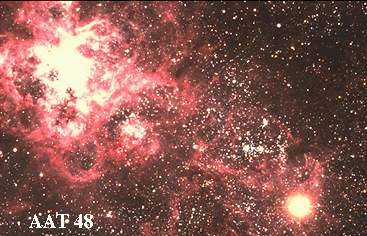 |
The Tarantula nebula and Supernova 1987a |
Among the commonest particles in the Universe are neutrinos. Like photons, they
outnumber the protons and neutrons of bulk matter by around one thousand millions to one.
Each cubic centimetre of space contains a hundred or so neutrinos left over from the Big
Bang at the beginning of the Universe. Every second, 60 thousand million neutrinos from
the Sun pass through each square centimetre of the Earth surface and through you!
|
When supernova 1987a blazed forth, the Earth was soaked with a tidal wave of neutrinos. Most passed through the Earth unheeded, but a few were caught in underground particle detectors. |
Paradoxically, neutrinos are probably the least understood of particles. They have no
electric charge, and interact with other matter only through the weak force. There are
three types of neutrino, which are like electrically neutral versions of the electron, and
its two heavier relatives, the muon and the tau. These neutrinos are all much lighter than
their charged counterparts, but we have no idea how much lighter or whether indeed they
have any mass at all. Neutrinos are so common in the Universe that even if they have only
a small mass their total effect could dominate the Universe!
The masses of the neutrinos are certainly smaller than we can measure by standard methods,
so experiments have to be more ingenious. One technique is to look for neutrinos changing
or "oscillating" from one type to another. This would be possible if, but only
if, one or more of the neutrino types has some mass. This exciting possibility could
explain why fewer neutrinos reach Earth from the Sun than expected, as the present
detectors pick up only one type of neutrino, the electron-neutrino. Experiments at CERN
with beams of neutrinos produced from particle collisions are also testing whether
neutrinos oscillate, at higher energies than the Sun produces.
© Copyright CERN - Last modified on 1998-02-18 - Tradotto da Sofia Sabatti